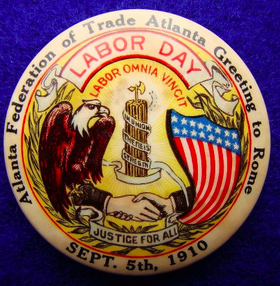| Information |
Labor Day, first proposed in 1882, became a national holiday under President Grover Cleveland in 1894 only six days after the end of the Pullman Strike (led by Eugene Debs). Labor Day originated as a celebration to honor the brave, dedicated men and women who fought against greed, political influence, wealth and privilege inherent in the industrial and manufacturing systems. They fought for safety, consideration, fairness and justice for all working classes. In those early days, Labor Day festivities usually included street parades and demonstrations by workers and their families. The day often included speeches by prominent citizens and politicians running for office. As years went on, Labor Day also included additional forms of celebration such as fireworks, food, sports, music and art exhibits.
Around the turn of the century, the distance between rich and poor was getting greater and greater. Laborers were getting progressively aggravated over their working conditions. Wealth and power were concentrated in large corporations and trusts which had significant influence over wages and working conditions. Workers wanted more control collectively over their lives. Clashes frequently broke out over these issues. Workers began to organize which resulted in the development of organizations such as the Socialist Party, Knights of Labor, and the IWW (Industrial Workers of the World).
By 1910, one-seventh of America’s population was foreign-born. Most of the large cities had large populations of immigrants who provided cheap labor to industry. 1910 was particularly violent. That year was marked by the Bethlehem Steel Strike, the Cloak Maker’s Strike, the Chicago Clothing Workers’ Strike (led by 15 year old Bessie Noramowitz), the Los Angeles strike wave, and the Philadelphia General Strike. The wives of striking coal miners were arrested that year in Greenburg Pennsylvania who sang their way out of jail under the leadership of Mary Harris “Mother” Jones (co-founder of the IWW and known at the time as “the most dangerous woman in the world” for her ability to organize workers).
Now, after that bit of introduction is this 1 3/4 inch 1910 Atlanta Labor Day pinback button made by Hyatt Mfg in Baltimore.
Nationally, Monday September 5th, 1910 was both a day of protest and day of celebration. In New York, 60,000 workers and others marched down Fifth Avenue with banners that said “Plutocracy Steals Our Soul and Then Calls Us the Great Unwashed”. Other cheered out for the principles of Karl Marx. In Los Angeles, 20,000 union members held a picnic on the beach that included dancing, fireworks and speeches. A march of 40,000 members took place in San Francisco which was followed by several songs sung by the Deutcher Arbeiter Sangerbund (German Workers Singers League). Immediately following their singing performance were gubernatorial candidates from the Democratic and Socialist parties giving speeches.
On that Monday in Atlanta, one of the longest parades in the history of the city took place. Among the parade carriages rode Atlanta Mayor Robert Maddox, Georgia Governor Hoke Smith, and Mr. S. B. Parks President of the Atlanta Federation of Trades. They were seen waving to the spectators who would be voting the following day in a “whites-only” Democratic primary (another interesting story). Following the carriages were groups of Atlanta laborers, workers and floats. There were barbers, firemen, butchers, stone masons, tailors, painters, plumbers, masons, machinists, car men, garment workers, sheet metal workers, paperhangers, printers, and press men. The Georgia newsboys were seen further down the line carrying banners that said “Georgian News Boys Are Always on the Job” and “Eight-Hour Work Day”. Also in the parade were the Brotherhood of Railroad Trainmen (who won first place for their float), the Red Men, and a group of blacks playing in a Dixieland band.
As an interesting note, on this same day in Fargo North Dakota, Teddy Roosevelt made a speech whereby he endorsed the plank of the Federation of Labor. In this speech, he stated that he endorsed (1) free schools, free text books and compulsory education (2) a work day of not more than eight hours (3) release from employment one day in seven (4) the abolition of the sweat shop system (5) sanitary inspections of the factory, work shop, mine and home (6) liability of employers for injury to the body or loss of life (7) the passage and enforcement of rigid anti-child labor laws and (8) suitable and plentiful playgrounds for children in all cities.
|

